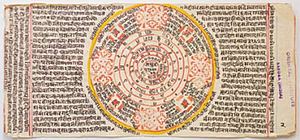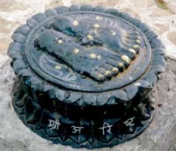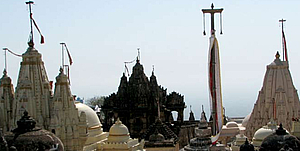
Centre of Jaina Studies Newsletter: SOAS - University of London
My PhD dissertation, currently in progress, examines the history of Śvetāmbara Jainism in the first half of the fourteenth century, a period of intense political upheaval in western India, through the life and works of the Kharatara Gaccha monk Jinaprabhasūri (12611333).
Known principally for his Vividhatīrthakalpa (Chapters on Various Pilgrimage Places) (VTK), a collection of narratives about various pilgrimage sites across North India, Jinaprabhasūri led a branch (śākhā) of the Kharatara Gaccha in the years immediately after the Delhi Sultanate's conquest of Gujarat, most notably during the reign of Sultan Muhammad bin Tughluq (r. 1325-1351). The VTK narrates how the monk formed a relationship with the sultan, which enabled him to acquire edicts (farmāns) securing pilgrimage routes and sites; he even recovered an image of Mahāvīra held in the sultan's treasury. Their friendship ultimately led to a new period of security and prosperity for both Śvetāmbaras and Digambaras (VTK: 96).[1]
Historians of late medieval India have used the VTK to corroborate the existence of temples at certain religious centers. In the 1990s, John E. Cort translated twelve of the text's 63 chapters; Phyllis Granoff translated various others in her studies of Jain biographical writing, pilgrimage, and in two essays on Jain literary responses to 'Muslim iconoclasm' during the conquest of North India.[2] Christine Chojnacki's (1995) French translation and study of most of the text assessed the nexus of physical and sacred geography. My thesis builds on some recent developments in the historiography of Hindu-Muslim relations, most notably Richard Eaton's work on temple desecration, to ask what Jinaprabha's purposes in writing the VTK might have been. His oeuvre provides a unique resource for seeing how Jains responded to the conquest and transition to the Delhi imperium.[3] I argue that the negotiation of access to and protection of pilgrimage sites is central to Jinaprabhasūri's political leadership; in turn, the new polity in North India helped to form a new way of linking pilgrimage sites together into a wide network belonging to the Jain tradition now thought of in its broadest sense.
The magnificent temples built in the Caulukya (Solanki) territories in the eleventh to thirteenth centuries attest to a period of prodigious Jain economic and political influence and cultural efflorescence. The Khalji conquest of the region around 1300, however, necessitated a reconfiguration of Śvetāmbara power. The Kharatara Gaccha emerged as the tradition's leading order; hagiographers and polemicists alike ascribe this in part to Jinaprabhasūri's success in the Tughluq court. My thesis seeks to understand the diverse agendas of the VTK, especially why the author places narratives of his own meetings with the sultan among those eulogizing various pilgrimage places. In so doing, I examine various features of this period of the Jain tradition, historically dismissed in scholarship as a period of Jainism's decline and 'turning inward'.
I begin by asking how Jinaprabhasūri cultivated himself to become the kind of monk who could successfully lobby for Jain interests in the Delhi court. To understand his career, I sought out both other works of the periodespecially the body of Jain narrative (prabandha) literature, of which the VTK is a unique partas well as the monk's own substantial oeuvre. Jinaprabha was the most prolific monk of his time with an opus exceeding 130 works,[4] which provide a panoramic window onto the intellectual, political and ritual worlds of fourteenth-century Jains. On the one hand, he was an intellectual who produced works on grammarincluding a commentary on Hemacandra's grammar and a telling of the life of King Śreṇika that illustrates grammatical rulesand composed some forty hymns of highly technical Sanskrit poetry (kāvya) that showcase various poetic techniques, including two hymns in multiple languages and a lengthy citra-kāvya. He also composed as many as three short poems in Persian. On the other hand, he was deeply involved in esoteric ritual practices, evidenced primarily by his detailed ritual manual, the Vidhimārgaprapā (The Well of the Path of [Proper] Conduct, the Kharatara Gaccha's more familiar appellation at that time). Further, he composed mantras for ritual and prophylactic purposes, as well as Prakrit hymns devoted to the goddess Padmāvatī, with whom his hagiographers detail a particularly close relationship as his personal protector while in the sultan's durbār. Finally, the VTK's chapters on Śatruñjaya and Girnār detail the presence of hidden quicksilver wells and the means of gaining access to them, suggesting that Jinaprabha was involved in the widespread practice of alchemy.

Folio 2 (verso) of Jinaprabhasūri's Nandiśvara Stavana Image © Baroda Oriental Institute, Vadodara

Complex of Caulukya-era temples, Girnār. Photo: Steven M. Vose, January 2011.
These two sides to Jinaprabhasūri's oeuvre frame the progression of chapters in my dissertation. While there is considerable overlap between the poetic and esoteric parts of his opus, I discuss them separately to highlight how they serve to establish two kinds of authority courtly and ritual. His kāvya works, I argue, fit into the prevalent medieval South Asian practice of composing highly technical Sanskrit poetry as a way of establishing a poet's bona fides in courtly settings. Further, such mastery would have allowed Jinaprabhasūri to participate in the courtly life of Delhi as a poet; indeed, the monk declares twice in the VTK that his poetic skills dazzled the sultan, in one case leading directly to the recovery of the Mahāvīra image.
The diverse body of works I bring together under the term 'esoteric' share in common an orientation toward a set of ritual practices empowered by both asceticism and devotion to the Jinas and the tutelary deities, especially goddesses, connected with them. For Jinaprabhasūri, as for the Kharatara Gaccha in general, devotion to Pārśvanātha and his attendant goddess, Padmāvatī, empowered the creation of new rituals and hymns, often imbued with new or creatively reformulated mantras, which had both soteriological and sublunary aims. I argue that by the time Jinaprabhasūri composed his ritual manual, Vidhimārgaprapā, the Kharatara Gaccha's power rested largely on the ability to develop and control a panoply of rituals for various purposes. Additionally, Jinaprabha's involvement in the practice of alchemy was a central part of the repertoire of the early Kharatara Gaccha monks. As ācārya of his order, Jinaprabha's leadership and reputation among lay and mendicant Jains, as well as tāntrikas, alchemists and astrologers from other traditions, was based on his command of rituals. This authority, I argue, licensed the monk to speak on behalf of the Jains in the sultan's court. It is also likely that the sultan would have found his command over such rituals particularly useful, an authority Jains would exercise a few centuries later in the Mughal courts.

A Śvetāmbara pagalā marks the site of Nemi's dīkṣā at Girnār.
A greater understanding of Jinaprabhasūri's career and works facilitates my reading of the VTK as both a politically and religiously pivotal text. I focus first on the chapters eulogizing the pilgrimage sites of Śatruñjaya and Girnār, which offer rich descriptions of the physical, spiritual and historical aspects of the sites. The blending of historical 'fact' with lists of the soteriologcial benefits of these sites is observable in two discursive modes: first, the aforementioned descriptions of how to find the hidden quicksilver wells; second, the descriptions of the temples and images as well as narratives of their desecration during the Khalji conquest and later restoration. In the first case, the mountains themselves bear precious materials, but are accessible only to those who perform the appropriate rituals and fasts and whose devotion compels the guardian deities to reveal their hidden locations. In the second, the destruction of temples and images are spoken of in terms of the power of the Dark Age (kali yuga); the mleccha armies of the Delhi Sultanate are merely its agents.

Śikharas and gilt kalaśas crown the temple city atop Mt. Śatruñjaya. Photo: Steven M. Vose, May 2010.
The thrust of these narratives becomes clear in the two chapters narrating Jinaprabha's success in obtaining the sultan's favors, which in my reading is the culmination of the VTK. The restoration of the temples and images is evidence not only of Jinaprabha's belief in the mutability of the kali yuga's deleterious effects, but of the Kharatara Gaccha's ability to mitigate its effects and lead all Jains, Śvetāmbara and Digambara alike, to continued prosperity under the new regime. The epitome of this new era is Muhammad bin Tughluq's establishment of a Jain quarter in Delhi to keep his monk friend nearby.
The VTK demonstrates that pilgrimage was one key area of political negotiation between the Delhi Sultanate and the Jains of western India, which monks like Jinaprabhasūri facilitated by participating in the intellectual life of the court. In turn, I argue that the new pressures to protect pilgrimage places and establish tax-free routes across new political boundaries crystallized a doctrine of pilgrimage within the Śvetāmbara tradition that now thought of these sites in a network reaching beyond the frontiers of the erstwhile Caulukya kingdom. In short, the advent of Sultanate rule facilitated the creation of a Jain sacred landscape linked together beyond the frontiers of the old regional kingdoms. Jinaprabhasūri's VTK is a key text that forged this new way of thinking.
With such a range of interests, Jinaprabhasūri is both unique as an individual and representative of the fourteenth-century tradition at large. The strong devotional character of his works suggests that the 'bhakti movement' beginning in the late fifteenth century did not radically transform Jainism as many histories of the tradition have claimed, nor did Jainism retreat into itself upon the advent of Muslim rule in western India. Jinaprabha's grammatical and poetic compositions in Sanskrit speak to a Jain engagement with the highest levels of Sanskrit intellectual culture, while his esoteric works show us the import of several now-denigrated practices once considered proper to Jainism. Indeed, the two sides of Jinaprabhasūri's oeuvre are closely linked, both as a set of practices and as a demonstration of the command of powers granting him the authority to represent the Jain community successfully in the court of the Delhi Sultanate. In the process, his career and works helped to forge a new sense of Jain identity and crystallized a new doctrine of pilgrimage in this changing political milieu.
Steven M. Vose is a PhD candidate in the Department of South Asia Studies at the University of Pennsylvania.
References
Vividhatīrthakalpa of Jinaprabhasūri. Jinavijaya, ed. Siṅghī Jaina Granthamālā, no. 10. 1934.
Chojnacki, Christine. 1995. Le Vividhatīrthakalpaḥ: Regards sur le lieu saint Jaina. Pondichery: Institut Français, École française d'Extrême-Orient. 2 vols
Translations of these narratives can be found in: Phyllis Granoff, "Jinaprabhasūri and Jinadattasūri: Two Studies from the Śvetāmbara Jain Tradition" in Speaking of Monks, P. Granoff, ed. (Oakville, Ontario: Mosaic Press, 1992), pp. 3-7, 12-17.
For Cort's translation and a biographical note on Jinaprabhasūri, see The Clever Adulteress, P. Granoff, ed. (Oakville, Ont.: Mosaic Press, 1990). Granoff's translations of two chapters from the VTK also appear in that volume. See also Granoff's essays, 'Tales of Broken Limbs and Bleeding Wounds: Responses to Muslim Iconoclasm in Medieval India', East and West (ISMEO) 41(1-4)(1991): 189-203; and 'The Jina Bleeds: Threats to the Faith and Rescue of the Faithful in Medieval Jain Stories', in Images, Miracles, and Authority in Asian Religious Traditions, Richard H. Davis, ed. (Boulder, Colorado: Westview Press, 1998).
Richard M. Eaton, "Temple Desecration and Indo-Muslim States," in Beyond Turk and Hindu: Rethinking Religious Identities in Islamicate South Asia, D. Gilmartin and B. Lawrence, eds. (Gainesville, Florida: University Press of Florida, 2000), pp. 246-281.
This is my own count based on fourteen months of research in manuscript archives in Gujarat and Rajasthanit is of course questionable whether he composed all these works himself. Jinaprabhasūri is remembered today for having gifted some 700 hymns to Tapā Gaccha monk Somatilakasūri, though I have yet to encounter any Tapā hymns attributed to his authorship and suspect that this story was deployed to claim a Kharatara source for Tapā hymns after the latter order surpassed them as the leading Śvetāmbara gaccha during the Mughal era.
 Steven M. Vose
Steven M. Vose